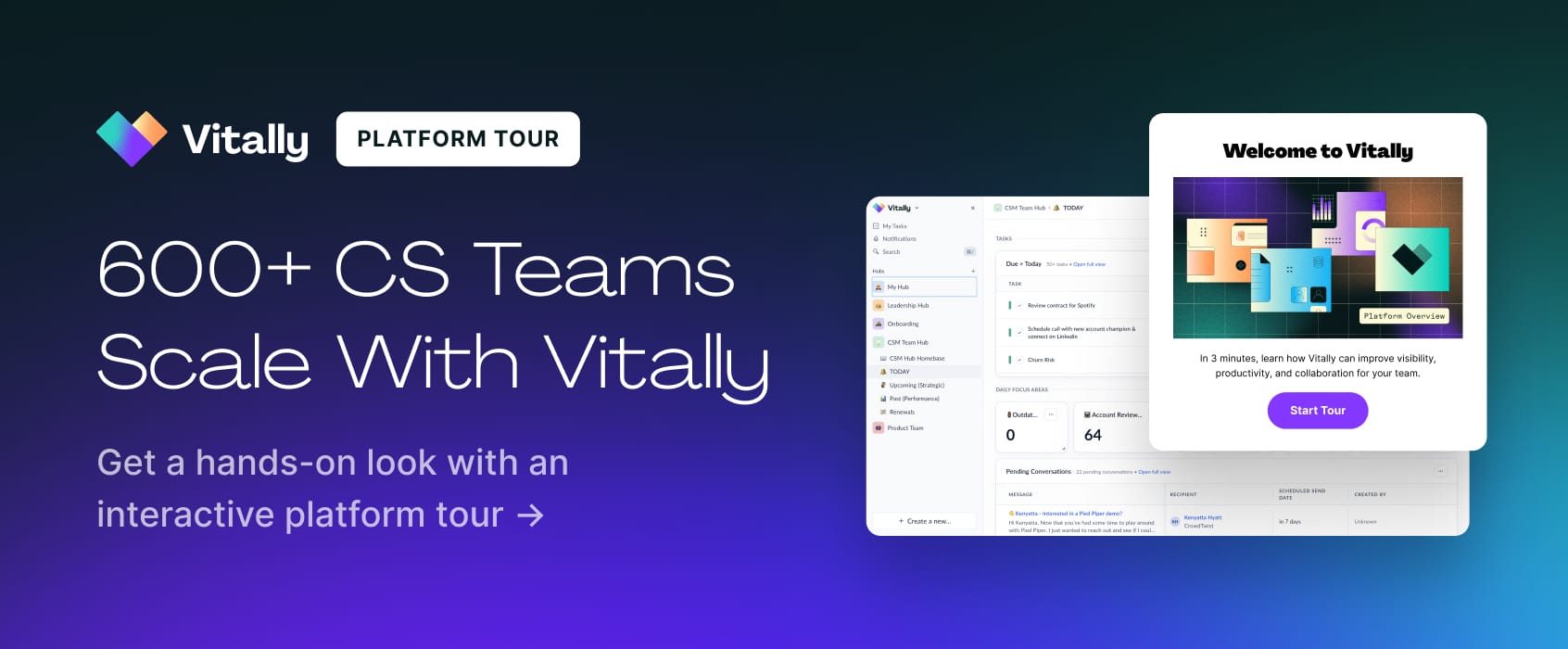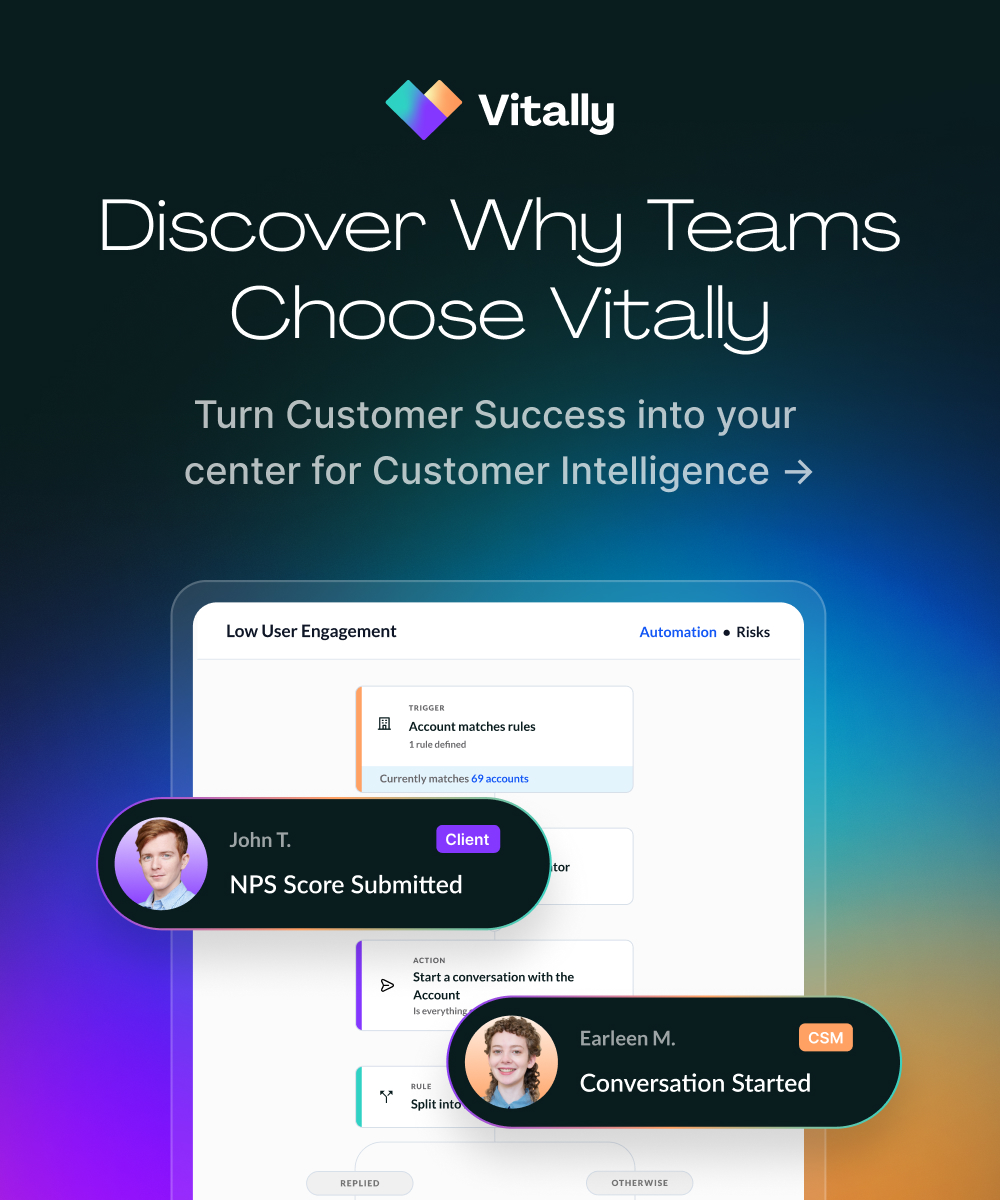
B2B organizations don't have a customer data problem; they have a data visibility problem.
In other words, they're talking more and more to customers but still struggle to act on the insights gathered.
Why? Because customer surveys are often siloed from the rest of your Customer Success strategy. Think about it: you're probably using a simple form builder, email, or even CRM software to collect survey responses, only to forget them when it's time for decision-making.
I sat down with Parker Moore, Senior Director of Operations and Customer Education at Vitally, and Christine Itwaru, Head of Vitally Product and Design, to learn how B2B businesses can build actionable surveys, solve their survey data visibility problem, and discover insights that drive business results.
To kick things off, here’s an overview of customer surveys and their most common use cases.
What Is a Customer Survey?
A customer survey is a method of collecting information from customers. It entails asking one or more questions to your customers either in person or through digital channels like email, social media, and survey tools. After they respond, you’ll sort out and analyze the data to extract meaningful insights that inform decision-making.
Customer surveys are mainly used to gather feedback about users' experience with your product or service. However, you can sometimes use them to discover your customers’ business priorities or even to track behavioral changes over the customer lifecycle.
What Types of Customer Surveys Should You Be Sending Out?
B2B businesses mostly take a reactive approach to surveys. This means they send out surveys to find out how a customer is feeling after completing an action — whether that's product onboarding or a conversation with the support team.
This isn’t wrong. Measuring customer sentiments is an important use case for surveys, but it isn’t the only one. Parker argues that B2B organizations can get more value if they also learn to use surveys to collect data and proactively inform decision-making.
With that, let’s look at the three types of surveys you should be sending to your customers:
1. Sentiment-Based Surveys
Gathering sentiments is by far the most common use case for surveys. It’s a way to check the pulse of your customers to know how they feel about your product and the overall experience. You'll use these insights to improve your offering and service delivery.
A typical example is net promoter score (NPS), which measures customer satisfaction and loyalty. However, you can also send sentiment-based surveys before or after key moments in the customer journey, such as account renewals and onboarding. For example, it’s a good idea to send a few check-in questions a month or so before an account renewal to know if the customer is happy with their experience and possibly surface and address issues that could lead to churn.
“The important thing is not to overdo it,” Parker says. “If you want to get feedback about how the customer feels about the product, you must give them enough time to experience it and form an opinion.”
“Also, if you've already collected sentiments, and nothing has changed in the product experience, there's no reason to send another sentiment-based survey to your customers.”
Related: How Molly From Upwards Gathers Detailed Customer Insights [Survey Blueprint]
2. Collaborative Surveys
A collaborative survey is used to collect information from the customer to help you complete a project successfully. Here, you’re not trying to learn about their feelings or collect feedback about their experience; you simply need data to inform work.
For example, let’s say the customer is planning a massive rollout of your product to their team. In that case, you can send out a survey to assess their team structure with questions like:
- What are the common learning styles on your team?
- Which features will resonate with them the most?
- What are the things that are most confusing for your team typically?
You’ll use these insights to customize their rollout plan to deliver the most value for the team. This could mean providing additional learning resources to cover product areas the team finds confusing or adapting product content into a format that matches the team’s learning style.
3. Differentiated Surveys
Differentiated surveys are used to gather out-of-the-box information to help you deliver more value to customers. You can administer them at the beginning of the relationship to set you up for success or ahead of strategic activities like account renewal or expansion.
For example, let's say you want to improve how your product drives key business outcomes for customers. In that case, you can create a goal-capture survey asking them to rank product features or benefits according to what's driving the most value for them. Then, use this data to inform future customer initiatives or product improvement.
Preparing for Customer Surveys
Here’s how to set your customer surveys up for success:
1. Set Your Survey Schedule
Decide on how often to send out surveys to customers. That way, you can plan and execute them in an organized and consistent manner instead of reacting last minute or scrambling to gather feedback when needed.
This is, unfortunately, where teams fall into the trap of sending too many surveys, explains Christine. “Sometimes, you’re trying to complete a quick action in an app, then a survey pops up, and it’s the same one you did last week. It disrupts the customer because it’s not useful.”
While there isn’t a golden rule for how often to survey customers, one thing is clear: You should only survey customers when there’s an important reason to do so and have a clear idea of how you’ll use their feedback or insights.
That said, Parker suggests two things to think about when setting your survey cadence:
- Type of customer: Lower-tier customers may not have as many opportunities to give one-on-one feedback to your organization — especially if the organization uses a pooled CS model. For that reason, you’ll want to send them surveys frequently. Higher-tier customers typically have a CSM they interact with regularly, and they can share most of their feedback during these conversations.
- Type of survey: Sentiment-based surveys, like NPS and CSAT, should be sent quarterly for new customers in the first year. From there, it can slow down to thrice a year for legacy customers. Collaborative and differentiated surveys should be sent on a case-by-case basis.
Once you set a schedule, let the customer know so they can prepare adequately. You could say, “Hey! Once we complete this process, we’ll send over a survey to help us understand how our product is working for you.”
2. Choose Your Customer Survey Tool
Choose a tool to create the survey and collect customer responses. You have many options for this — from native survey tools to adapted solutions like form builders and emails.
“The biggest problem with many survey tools is that they aren’t tied to the customer lifecycle. So you’re getting information that might be really good but can’t tie it back to the customer behavior because it’s siloed,” says Christine.
Parker shares a similar point of view. “These tools create layers of separation between the customer, the person who works with the customer, and whoever is actually accessing the data and making meaning out of the survey.
“At best, this means that there are some friction points. And at worst, it means you’re never taking action on the survey information. You’re just ingesting information but not doing anything with it.”
To avoid this, consider administering where the rest of your customer interactions happen and are stored, such as a Customer Success Platform like Vitally. It will help you:
- Eliminate broken feedback loops
- Identify patterns in customer feedback
- Quickly implement data insights across your customer lifecycle
3. Draft Your Survey Questions
Ask non-leading survey questions to limit survey bias. A leading question slightly nudges a customer to give the answer you want. For example:
- Share how much you enjoy using the product.
This question is leading because it assumes that the customer likes the product, but their experience might be different. Instead, you should ask:
- What is your experience with the product so far?
“Asking non-leading questions is super important because if your questions are biased, your data will be biased. And you end up making a decision based on what you already think versus what the customer is actually telling you,” says Christine.
Related: The Top 8 Survey Questions CS Teams Should Ask Their Customers
4. Get a Second Opinion on the Survey Workflow
Ask your team members to go through the entire survey process and provide feedback. Let them receive the email, click the link, open the page, and move through the questions. This way, they can give you feedback like, “This is super cumbersome; I’d never do this,” or “This question is worded weirdly, and I don’t know what you're looking for.”
“Don't provide any context about the survey to your team members,” says Parker. “Just share it internally with a note like, 'I have a survey. Can you look through this and tell me if you understand what I'm trying to gather?' Give them zero context because that's the situation your customers will likely be in. That’s how you get actionable feedback.”
5. Use Incentives to Encourage Responses
The easiest way to incentivize your customers is to reward them for participating in your survey. For example, you can say, “Hey, if you fill this out, we'll give you a gift card.”
But you don’t always have to do this. Another effective incentive is to show how the survey benefits your customers and how you plan to use their input. Make sure there's clarity there.
“Let your customers know the survey is coming and how important it is to you,” says Parker. “Show them that you value their feedback and take action on it. Often, people assume that companies either don’t care or won’t do anything with their feedback, so it's crucial to address those objections right from the start."

How to Create a Customer Survey
Once you’ve figured out the type of survey you want to share and the questions to ask, the next step is to build it out.
Vitally’s Custom Surveys feature lets you create and administer different customer surveys — from traditional NPS and CSAT surveys to the more specialized ones for goal capture. Follow this step-by-step guide to create your first customer survey in Vitally.
Step 1: Click on “settings” in your Vitally dashboard, scroll down to “activity,” and select “surveys.”

Step 2: Select New Survey on the top right corner of your dashboard and add your preferred survey title.

Step 3: Add a welcome and goodbye message to your survey. Your welcome message should provide an overview of the survey, and the goodbye message should thank customers for participating.

Step 4: On the left-hand panel of your dashboard, you'll find 11 types of survey questions you can use. Select or drag and drop any question in the order you want.

Step 5: Add your question and options if required. You can customize questions by making them compulsory (or optional) and limiting text input.

Step 6: Preview the survey to ensure you set things up correctly.

Step 7: Publish and share your customer survey. Vitally lets you embed surveys into customer conversations directly, share them via personalized or generic links, or add them to customer playbooks as part of your customer engagement sequences.

How to Analyze Customer Survey Data and Results
To analyze customer survey data, you must look at survey engagement metrics before digging into the responses for trends or insights.
1. Start With Your Survey Engagement Metrics
Survey engagement metrics measure how customers interacted with your survey. They help you gauge your audience's interest in the survey content and any frustrations they might have encountered while filling it out.
For example, if the number of people who submitted the survey is significantly lower than those who began answering it, it’s a sign that the survey design might not be user-friendly or maybe you asked too many questions.
These metrics are usually captured in your survey tool. For example, Vitally automatically tracks the total survey completion rate, the total number of views and responses, the number of people who started the survey versus those who submitted, and so much more.

2. Go From Micro to Macro When Interpreting Results
“One piece of data hardly tells the whole story, so you can’t just run with it. You need to kind of zoom out and compare what you’re seeing with other business and customer insights to have a clearer picture,” explains Parker.
Parker and Christine suggest adopting a micro-to-macro survey analysis approach. First, look at the individual user who gave the feedback, whether good or bad and track if you’ve received responses from them in the past. See if there's a change or if it's consistent.
Then, zoom out and look at the account. If it's a larger organization, consider the specific persona that the user falls within. From there, expand your view to others within the organization and then to the organization as a whole. Look at trends across all users within that account.
You can zoom out even further to the segment the customer operates in and the persona within that segment to see emerging trends. Finally, expand to the entire segment and then across all customer sets to observe the overall survey trends. This way, you're not over-indexing on any single response but gradually zooming out to understand if there's a larger trend, good or bad, that must be addressed.
How to Take Action on Survey Results
Now that you have all of this information, what do you do with it? Parker says a lesser-known strategy for utilizing survey results is to use them for self-assessment.
“Customer feedback presents a great opportunity for self-learning, especially for your CSMs. Paying attention to this information can help them discover and correct otherwise ignored mistakes — all by themselves.”
However, it’s not a straightforward process. Customer feedback is mostly a mixed bag. As a CSM, you need to differentiate feedback about you from feedback about the general CS process and product.
“For example, if a customer says they’re not engaging enough with their CSM, it might not be a CSM issue. It could be an expectation-setting problem during the sales process or a sign that the CS engagement model needs adjustment. So, there’s a lot of gut-check involved,” explains Parker.
Beyond that, you can also use survey insights and data to:
- Create playbooks that signal risks or opportunities internally.
- Create and distribute content assets like case studies based on customer feedback.
- Develop new products (and features) to address challenges that surfaced in customer feedback.
- Create customer research reports ahead of strategic meetings (for upselling, cross-selling, or mitigating churn risks).
Use Surveys to Continuously Drive Action Across the Customer Lifecycle
Surveys should be more than a one-time tool for gathering isolated feedback for your customer teams. Instead, create a loop where the insights gathered continuously feed into the business processes across all your teams.
Vitally helps you achieve this. Our Custom Survey tool, plus other important CSP features, empowers B2B organizations to collect and act on customer survey data in real time.
Want to learn more about how Vitally works? Schedule a demo with our team or take our interactive tour.










